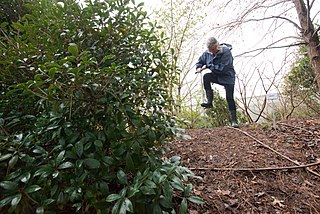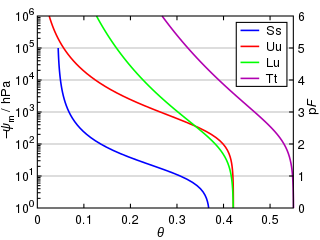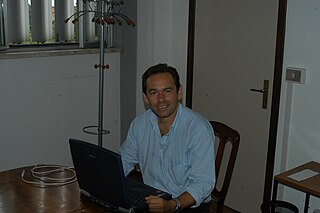Related Research Articles

Soil test may refer to one or more of a wide variety of soil analysis conducted for one of several possible reasons. Possibly the most widely conducted soil tests are those done to estimate the plant-available concentrations of plant nutrients, in order to determine fertilizer recommendations in agriculture. Other soil tests may be done for engineering (geotechnical), geochemical or ecological investigations.
Soil moisture is the water content of the soil. It can be expressed in terms of volume or weight. Soil moisture measurement can be based on in situ probes or remote sensing methods.
In science and engineering, hydraulic conductivity, is a property of porous materials, soils and rocks,< that describes the ease with which a fluid can move through the pore space, or fractures network. It depends on the intrinsic permeability of the material, the degree of saturation, and on the density and viscosity of the fluid. Saturated hydraulic conductivity, Ksat, describes water movement through saturated media. By definition, hydraulic conductivity is the ratio of volume flux to hydraulic gradient yielding a quantitative measure of a saturated soil's ability to transmit water when subjected to a hydraulic gradient.

Water content or moisture content is the quantity of water contained in a material, such as soil, rock, ceramics, crops, or wood. Water content is used in a wide range of scientific and technical areas, and is expressed as a ratio, which can range from 0 to the value of the materials' porosity at saturation. It can be given on a volumetric or mass (gravimetric) basis.
Soil functions are general capabilities of soils that are important for various agricultural, environmental, nature protection, landscape architecture and urban applications. Soil can perform many functions and these include functions related to the natural ecosystems, agricultural productivity, environmental quality, source of raw material, and as base for buildings. Six key soil functions are:
- Food and other biomass production
- Environmental Interaction
- Biological habitat and gene pool
- Source of raw materials
- Physical and cultural heritage
- Platform for man-made structures
Claypan is a dense, compact, slowly permeable layer in the subsoil. It has a much higher clay content than the overlying material, from which it is separated by a sharply defined boundary. The dense structure restricts root growth and water infiltration. Therefore, a perched water table might form on top of the claypan. In the Canadian classification system, claypan is defined as a clay-enriched illuvial B (Bt) horizon.

Infiltration is the process by which water on the ground surface enters the soil. It is commonly used in both hydrology and soil sciences. The infiltration capacity is defined as the maximum rate of infiltration. It is most often measured in meters per day but can also be measured in other units of distance over time if necessary. The infiltration capacity decreases as the soil moisture content of soils surface layers increases. If the precipitation rate exceeds the infiltration rate, runoff will usually occur unless there is some physical barrier.
Field capacity is the amount of soil moisture or water content held in the soil after excess water has drained away and the rate of downward movement has decreased. This usually takes place 2–3 days after rain or irrigation in pervious soils of uniform structure and texture. The physical definition of field capacity is the bulk water content retained in soil at −33 kPa of hydraulic head or suction pressure. The term originated from Israelsen and West and Frank Veihmeyer and Arthur Hendrickson.

Permanent wilting point (PWP) or wilting point (WP) is defined as the minimum amount of water in the soil that the plant requires not to wilt. If the soil water content decreases to this or any lower point a plant wilts and can no longer recover its turgidity when placed in a saturated atmosphere for 12 hours. The physical definition of the wilting point, symbolically expressed as θpwp or θwp, is said by convention as the water content at −1,500 kPa (−15 bar) of suction pressure, or negative hydraulic head.
Available water capacity is the amount of water that can be stored in a soil profile and be available for growing crops. It is also known as available water content (AWC), profile available water (PAW) or total available water (TAW).
The non-limiting water range (NLWR) represents the range of water content in the soil where limitations to plant growth are minimal. John Letey (1985) from UC Riverside introduced the NLWR concept in an attempt to integrate several physical properties associated with plant or root growth to refine the concept of available water capacity. Alvaro Pires da Silva, Bev Kay, and Ed Perfect (1994) refined the concept and termed it least limiting water range (LLWR).

Water retention curve is the relationship between the water content, θ, and the soil water potential, ψ. This curve is characteristic for different types of soil, and is also called the soil moisture characteristic.
Soil texture is a classification instrument used both in the field and laboratory to determine soil classes based on their physical texture. Soil texture can be determined using qualitative methods such as texture by feel, and quantitative methods such as the hydrometer method based on Stokes' law. Soil texture has agricultural applications such as determining crop suitability and to predict the response of the soil to environmental and management conditions such as drought or calcium (lime) requirements. Soil texture focuses on the particles that are less than two millimeters in diameter which include sand, silt, and clay. The USDA soil taxonomy and WRB soil classification systems use 12 textural classes whereas the UK-ADAS system uses 11. These classifications are based on the percentages of sand, silt, and clay in the soil.

Gianni Bellocchi is a researcher in agricultural and related sciences. He is credited with the development of approaches and tools in validation of estimates and measurements. Introduction of fuzzy logic in the context of validation is often considered to be the most significant contribution to the field of model and method validation.

Geotechnical investigations are performed by geotechnical engineers or engineering geologists to obtain information on the physical properties of soil earthworks and foundations for proposed structures and for repair of distress to earthworks and structures caused by subsurface conditions; this type of investigation is called a site investigation. Geotechnical investigations are also used to measure the thermal resistance of soils or backfill materials required for underground transmission lines, oil and gas pipelines, radioactive waste disposal, and solar thermal storage facilities. A geotechnical investigation will include surface exploration and subsurface exploration of a site. Sometimes, geophysical methods are used to obtain data about sites. Subsurface exploration usually involves soil sampling and laboratory tests of the soil samples retrieved.
The pore space of soil contains the liquid and gas phases of soil, i.e., everything but the solid phase that contains mainly minerals of varying sizes as well as organic compounds.
Groundwater models are computer models of groundwater flow systems, and are used by hydrologists and hydrogeologists. Groundwater models are used to simulate and predict aquifer conditions.
Soils can process and hold considerable amounts of water. They can take in water, and will keep doing so until they are full, or until the rate at which they can transmit water into and through the pores is exceeded. Some of this water will steadily drain through the soil and end up in the waterways and streams, but much of it will be retained, despite the influence of gravity. Much of this retained water can be used by plants and other organisms, also contributing to land productivity and soil health.
Modelling frameworks are used in modelling and simulation and can consist of a software infrastructure to develop and run mathematical models. They have provided a substantial step forward in the area of biophysical modelling with respect to monolithic implementations. The separation of algorithms from data, the reusability of I/O procedures and integration services, and the isolation of modelling solutions in discrete units has brought a solid advantage in the development of simulation systems. Modelling frameworks for agriculture have evolved over time, with different approaches and targets
Constructed soils are mixtures of organic and mineral material derived from a number of sources, including repurposed organic waste, that are designed to approximate natural soils and provide a growing medium for plants. Constructed soils are commonly used in the reclamation of degraded land where natural topsoil is either not present or has been contaminated. Examples of these sites include mines, landfills, and other industrial or urban areas. Constructed soils are classified as Technosols, and often form the upper layer, or layers, in a Technosol above a geomembrane or other barrier capping waste material.
References
- ↑ Bouma, J. (1989). "Using Soil Survey Data for Quantitative Land Evaluation". Advances in Soil Science. Vol. 9. pp. 177–213. doi:10.1007/978-1-4612-3532-3_4. ISBN 978-1-4612-8144-3.
- ↑ Acutis, M., and Donatelli, M. (2003). "SOILPAR 2.00: software to estimate soil hydrological parameters and functions". European Journal of Agronomy. 18 (3–4): 373–377. doi:10.1016/S1161-0301(02)00128-4.
{{cite journal}}: CS1 maint: multiple names: authors list (link) - ↑ Schaap, M.G., Leij, F.J., and van Genuchten, M.Th. (2001). "rosetta: A computer program for estimating soil hydraulic parameters with hierarchical pedotransfer functions". Journal of Hydrology. 251 (3): 163–176. doi:10.1016/S0022-1694(01)00466-8.
{{cite journal}}: CS1 maint: multiple names: authors list (link) - ↑ Minasny, Budiman (2007). "Predicting soil properties". Jurnal Ilmu Tanah Dan Lingkungan. 7 (1): 54–67.